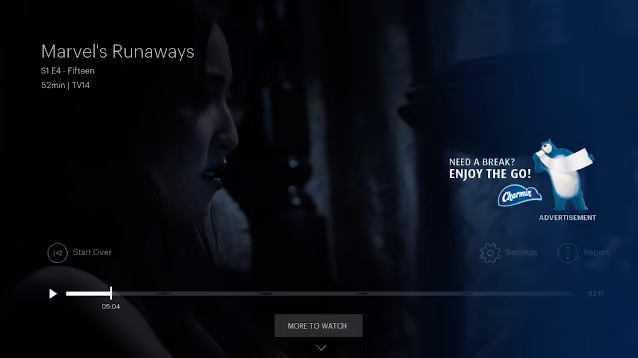OTT revenue is expected to grow at a compound annual growth rate (CAGR of 10.01% between 2023 and 2027, when it will reach $462.9 billion.
Meanwhile, eMarketer predicted that 1.8 billion people would subscribe to OTT platforms like Netflix, Hulu, and HBO Max in 2022—and not just one of them. The average household used an average of 6.8 streaming services in March 2022.
Unsurprisingly, advertisers have taken notice of the growth. According to Statista, OTT advertising will have a market volume of $205.1 billion this year.
Every major OTT player is responding accordingly—even Netflix recently launched an ad-supported tier.
But what do these ads actually look like?
Here are three examples:

3 Innovative OTT Ad Types to Add to Your Campaigns
Everyone knows about pre- and post-roll ads. The mid-roll variety, too. All three formats are common across YouTube and exist in OTT’s advertising ecosystem.
There’s more out there, though, and the other ad formats can help you stand out.
Binge Ads
In 2020, Kellogg Cereal Company was one of three brands to partner with Hulu to test the new Binge ad format. Maker’s Mark was part of the test, too.

According to Gail Horwood, Chief Marketing Officer, Kellogg’s North America, the decision to invest in the innovative ad format come down to “a laser focus on consumer occasions.” She said this focus is “one lever we pull when making marketing decisions at Kellogg.”
Here’s how Hulu’s Binge ads work: Once one of Hulu’s nearly 50 million users reaches a third episode, a message informs them that the next episode will be ad-free (this message could be “presented by Sparkle,” for example). The ad will also include a unique offer from the brand.
Hulu uses data on its users to predict when they’re likely binge-watch a show. When this threshold is met, Hulu will serve “contextually relevant messaging from our brand partners that acknowledges a binge watching session has begun.”
The release of Binge ads comes as brands chose to target a big frustration point for their viewers and remove interruptive ads from streamed content.
Hulu also launched Pause Ads in 2019, which provide a “non-intrusive, viewer-initiated ad experience that is both delighting to views and effective for brands.”
Unlike traditional ad formats that play during content, Pause Ads are don’t interrupt the storytelling experience. Instead, they appear with a viewer pauses content they are watching.

QR Codes
Other brands worked to make intrusive ads less irritating by making them interactive and rewarding.
Burger King, for example, ran an OTT ad with a QR code that moved around the screen. Those who scanned the code got a free Whopper.
The idea was that viewers would be more inclined to pay attention to ads and visit the nearest Burger King if they saw and interacted with something new.
QR codes in ads are nothing new—advertisers jumped at the new opportunity to engage consumers in new ways the second smartphones offered the capability. They fell out of favor, though—at least until recently.
NBCUniversal introduced Shoppable TV commercials with scannable QR codes, while Pepsi incorporated QR codes in its packaging. And you can’t mention QR codes without bringing up Coinbase’s viral Super Bowl ad in 2022. The ad was so popular that it crashed the company’s app.
While the aforementioned examples weren’t delivered on OTT platforms, they illustrate the resurgence of QR codes, which may translate to Netflix, Hulu, HBO Max, and other platforms.
Ad Selector
Hulu’s Ad Selector allows users to control their ad experience by picking which ad they want to see. (See below.)

Hulu users will see two or three ad options from which they can select. If they don’t pick one, Hulu will randomly play one.
While Ad Selector isn’t as new as Binge Ads, it reflects the premium Hulu puts on the user experience—a sentiment other OTT platforms will have to adopt if they want to attract ad dollars.
Hulu: A Catalyst for OTT Advertising Innovation
Hulu’s been making moves in the OTT advertising world for some time. In 2020, the streaming giant a self-serve ad platform to help small-to-medium businesses to buy ads. Given OTT’s nascent status and relatively complex ecosystem, advertisers were undoubtedly appreciative.
Hulu continues to innovate. Most recently, it did that with Binge Ads and GatewayGo, the latter giving users the chance to interact with the advertisers and receive personalized offers.
While much of the OTT advertising innovation is coming from Hulu, it’s also forcing the hands of its competitors. For the likes of Netflix, HBO Max, and Disney+, their ability to sustain growth—from both a user and advertising standpoint—will rely in some part on their ability to evolve their ad offerings in the best interest of everyone evolve. That’s good news for all.
For more insights, sign up for MediaRadar’s blog here.



